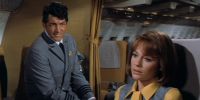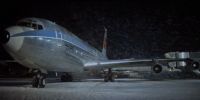
This is the movie that started it… The trend of the 1970s disaster movies. It was at the time when the Boeing 707 was king of the airports, and a lot of drama and an all-start cast made movies great. This is what Airport, based on Arthur Hailey’s excellent novel of the same name, is all about.
Plot summary
It all starts at Chicago’s Lincoln International Airport. You guessed it, that’s a fictitious airport! It’s the worst snowstorm in six years. The first sequences of the movie show the snowed parking lots, the runways being plowed, and, at night, the congested terminal. Then, the control tower monitors the arrival of Trans Global Airlines flight 45 on runway two-niner (29). This is where trouble starts…
The pilot of the Boeing 707, after landing, tries to turn off the runway at a shortcut, but because of the snow on the taxiways, sends his plane out of the runway, with landing gears right into the snow! This means runway 29, the longest runway of the airport, is shut down, all flights have to use runway 22 (which is right next to Meadowood, a residential area), and the passengers of Global 45 have to use the mobile stairways!
Mel Bakersfeld (Burt Lancaster), general manager of the airport, is called at the site of the incident. Yet one more thing that will prevent him effectively from getting home for dinner. Once again. Mel’s wife Cindy (Dana Wynter) is starting to get more than enough. He has to call Joe Patroni (George Kennedy), a TWA mechanic, to see what he can do. It is the first appearance of the legendary character of Joe Patroni, which we see in all four Airport movies.
Captain Vernon Demerest (Dean Martin) is dropped by at the airport by his wife Sarah (Barbara Hale), who happens to be the sister of Bakersfeld. He’s on his way to Rome, on Trans Global Airlines, flight 2, the “Golden Argosy”. The two in-laws don’t get along very well. Vernon has just written a very heavy report on how the lack of snow equipment causes delays, heavy losses of revenue for the airlines, etc. Right after Vernon’s wife drives back home, he takes a cab right away to see… Gwen Meighen (Jacqueline Bisset), his young, good-looking mistress, who is the chief stewardess (and NOT flight attendant!) on flight 2.

Tanya Livingston (Jean Seberg), from the public relations department of Trans Global Airlines, meets the latest stowaway on Trans Global. She is used to see male teenagers but now it’s… an elderly lady, Ada Quonsett (Helen Hayes)! Mrs. Quonsett is a very lovable character, always having interesting anecdotes about her late husband, and always treating people with respect, even Tanya, who has an immediate dislike to her. Helen Hayes, the “First Lady of the American Theater”, earned a well-deserved Oscar for Best Supporting Actress in 1970, for this movie.
We also see D.O. Guerrero (Van Heflin), in his room. He is up to something… a bomb! Inside an attaché case. A little string, the battery connects, the dynamite lights, and BOOM! His plan is to leave his wife Inez (Maureen Stapleton) with the insurance she’ll collect, when Trans Global Airlines, flight 2, goes down. It seems the only way to save the couple from financial disaster. We later learn that Guerrero was a patient in a mental hospital.
Mrs. Quonsett is escorted by Peter Coakley (John Findlater), a young and obviously naive employee of TGA, to her flight back to Los Angeles. She was caught by an off-duty police officer on a flight to New York, to see her daughter. Extremely clever, Mrs. Quonsett manages to distract Mr. Coakley and gets on flight 2, just as they are about to pushback. Harry Standish (Lloyd Nolan), a customs officer, who happened to be near the flight 2 gate (to say goodbye to his niece), notices D.O. Guerrero’s strange attitude.

At last, after a delay of one hour due to weather conditions (it was in fact the downtown bus shuttle that was delayed due to traffic), flight 2 takes-off from Chicago and leaves for Rome. Capt. Anson Harris (Barry Nelson) is in the left seat, Capt. Demerest in the right seat, as a check pilot, and Second Officer Cy Jordan is the Flight Engineer (Gary Collins). Standish is still worried about what that passenger with the attaché case might be up to. This is going to be a bumpy night!
Appreciation
This movie is very interesting to watch. Aviation fans will be delighted to notice all the accurate technical details, and all the research author Arthur Hailey, and director George Seaton made. You might get bored with all the soap-opera-like drama at the beginning, but I believe this helps build the atmosphere, and get to know the characters. Starting straight at the departure of flight 2 would have made a horrible movie. Another thing that might disappoint you is that the air-to-air sequences are made using a toy model of a Boeing 707. Remember it’s 1970 and the special effects are not excellent.
Airport deserves 8.5 out of 10. If you have not yet seen this classic of the air disaster movies, you are definitely missing something.
Things to notice
Airport is very accurate and there are no obvious goofs regarding aviation. Here are the things to notice (on slow motion), and the trivia.

- There are no TV monitors or flight information panels. The information is provided by each airline at each counter, on a poster board.
- Notice a scale model of a Concorde bearing the TWA livery at the conference room where Bakersfeld talks to his boss. Remember it was the time when nearly all the big airlines in the world ordered one of these.
- The passengers at Lincoln board the 707 from two different gates: the front gate for the First Class passengers and the aft gate for the passengers on Economy. It was a widely used technique for the Boeing 707s at the time.
- In 1970, there is no law that prohibits smokers and non-smokers to be placed in the same cabin on a passenger aircraft. Such law will be adopted in 1974.
- Among the objects sucked out by the decompression (besides D.O. Guerrero), are a cigarette, some playing cards, many empty food trays, a broken hat, an “attaché” case, blankets and pillows. There is no paper sucked out, unlike the air disaster movies after Airport.
- We have found Lincoln Airport! It’s at the Minneapolis/St. Paul Airport, where the movie was shot.
- Now that you know the real location, no wonder the concourses in the main terminal are not identified by letters or numbers, but rather by COLORS (the GREEN concourse, the RED concourse, etc.), just like Minneapolis/St. Paul Airport in the old days!
Here are some trivia that compares the movie and the novel:

- Almost all of the characters from the original novel have been preserved for the movie, along with their names.
- I suppose that, to make things easier and to save as much money as possible, the two “incident” planes (Global 45 into the snow, and Global 2 going down) are from the same airline. That is not the case in the novel. The plane in the snow is from Aéreo Mexican (an airline name that is an irrelevant mix of Spanish and English… and AeroMexico). The airline known as Trans Global in the movie was… Trans America in the novel.
- In the movie, it is the plane, and not the route, that is named “Golden Argosy”, because of its luxurious cabin and world-class service. The Trans America Boeing 707 bears, in the novel, the registration N631TA.
- Lincoln Airport is designed differently in the novel. The runways mentioned are 30 (shut down by the Aéreo Mexican 707), 25 (active departure runway), and 17 (I think the book mentions “left”).
- Here are two of many scenes appearing in the novel have been omitted in the movie. First, a scene where Bakersfeld and Demerest open a debate about whether flight insurance should be sold at the airports. Later, another one where Bakersfeld deals with a lawyer (Mr. Freemantle), representing angry Meadowood residents.
- Gwen and Vernon’s argument about an eventual abortion is much more straightforward in the novel and the word “abortion” is actually used more than once. The alert reader will recognize it as the same one the two P.A. announcers have in the opening sequence of Airplane! (“Oh really, Vernon! Why pretend?”)
The aircraft

Trans Global Airlines flight 2 is a Boeing 707 flying the “Golden Argosy” route, from Chicago (Lincoln) to Rome. Its registration code is N324F.
The REAL aircraft
N324F, a Boeing 707-349C (msn/ln 19354-503), was delivered to Flying Tiger Line on June 21, 1966. Since then, it had the following registries: EI-ASO, VH-EBZ, G-BAWP, 9J-AEC, S2-ACG, and finally PT-TCS, on Transbrasil Airlines. Sadly, on March 21, 1989, it crashed while making a final approach at São Paulo-Guarulhos Airport. The three occupants of this freight flight, plus 18 people on the ground died.
Movie links
- IMDb – Airport
Cast, plot summary, quotes, from the world’s widest movie database. - Wikipedia – Airport (film)
Very detailed description of all four Airport movies, including spoilers! - Airporthotels.com – Airports in the movies
Blog entry about Airport and other movies set at an airport.
Specifications
U.S.A. 1970, Produced by Universal Studios. Directed by George Seaton. Starring Burt Lancaster, Dean Martin, Jacqueline Bisset, George Kennedy, Helen Hayes, Van Heflin. Rated G. Also known as Airport (French, German).


This movie shows the most accurate depiction of a precision approach (radar) approach in any movie. All of the procedures followed and radio calls were correct. Usually, a pilot uses an ILS approach in reduced ceiling/visibility conditions but some prefer the addition guidance provided by a PAR controller, especially for difficult approaches which this most definitely was. The controller directed them to carry out an ILS approach if radio comm was lost, which was correct. They had strong winds with gusts along with a low ceiling and they had to work with these conditions all while carrying extra speed to compensate for the loss of rudder authority (very important for crosswind landings) caused by the bomb damage. I’m an airline pilot and I remember this approach scene often when I’m descending into bad weather for landing.
Nice page! Well done. Loving this film is my guilty secret. But you’re right — once you allow for half-a-century of film-making advancement, the movie holds up really well. It doesn’t try to be anything other than what it is: a disaster movie with a good grounding in human drama.
Here’s a niggly thing: AeroMexico went with DC8s and never flew any 707s!
Cheers,
Mike
Still one of my favorite movies and a great adaptation of a well written novel, which is usually rare. From the opening snowy scenes coupled with Alfred Newman’s aggressive musical score, you’ll be hooked. Yes, a bit corny at times, but all in all a very entertaining, factually correct (mostly) big budget Hollywood film. For 1970, the special effects were actually pretty damn good, and if you’re caught up with the story you don’t notice – something modern filmmakers could take a note from. It’s the characters and story that count, not the size or volume of the effects!
I watched it last night on HBO and was surprised that it held up rather well. Even some of the corny cliches — slapping someone across the face to calm them — somehow lent an air of quaint charm. I also noticed how cheesy the long shots of the plane, with the stars in the background, looked.
Your original statement about Chicago’s Lincoln International Airport is actually O’Hare, the office with the Conord model has the current layout of the airport. Runway 22 and 29 do exist.
During the movie they got the termanology and FAA regulations right, KUDOS.
@Joe: Thanks for the info, but it looks like you’re quoting me out of context. All I said was that the runway designations for fictional Lincoln International Airport in the movie are not the same as in the novel.